Our Story
In 1893 Clifford Essex and Alfred D. Cammeyer formed a partnership with offices and teaching studios at 59 Piccadilly, London. At first, the banjos and zither-banjos they sold under the brand name of ‘Essex & Cammeyer’ were made for them by Temlett, Weaver, Wilmshurst and Windsor, but early in 1896 they opened their own workshop at 13 Greek Street, Soho, and soon employed fourteen workmen to make banjos and zither-banjos for them. In 1900, the two men agreed to follow separate paths and the production of ‘Essex & Cammeyer’ instruments ceased.
In 1900 Clifford Essex & Co. was born, and in 1903 Clifford Essex launched BMG, the magazine for all players of fretted instruments. Clifford Essex banjos, mandolins and guitars have a history of being made by superior craftsmen, and to this day they are in huge demand throughout the world. When Clifford Essex dissolved his partnership with Cammeyer in 1900, he formed his own firm at 15a Grafton Street, New Bond Street, London. Instruments bearing the name Clifford Essex Co. were put on the market, and at first all the banjos were made for Clifford Essex by Spencer, Weaver, Langham [London] and Houghton [Birmingham]. In 1904 he started his own workshop at The Oval, Kensington, with Alfred Dare as foreman, and when Spencer died in 1915, Clifford Essex bought his plant and stock and took his key craftsmen into his employ.
Although most of the Clifford Essex instruments sold in those early days were made in the Clifford Essex workshops, some were still made by the above-mentioned outside makers. The Weaver-made banjos were made to Weaver’s own design, although they were sold with the Clifford Essex label on them. In December 1919 the firm’s title changed to Clifford Essex & Son, and by then only their cheapest model ‘The Popular’ was made outside their own workshops by Houghton of Birmingham. A. P. Sharpe, a former Managing Director of Clifford Essex, wrote several very informative books which were published by the company.
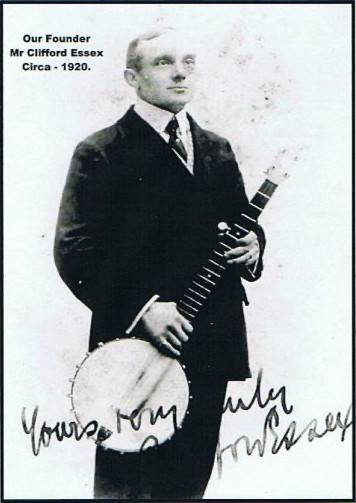
In February 1936 the firm became a private limited company, and the title changed to Clifford Essex & Son Ltd. Soon after the outbreak of World War 2 the manufacture of musical instruments was greatly reduced due to a shortage of materials and the military call up of craftsmen. The firm went into liquidation in 1942, and all manufacturing ceased, but A. P. Sharpe, as a former employee of Clifford Essex, re-formed the company under the title Clifford Essex Music Co. Ltd, and continued to make quality musical instruments.
After demobilisation in 1945, Marco Roccia, master luthier, who had joined the company in 1927, returned to his position with the Clifford Essex Music Co. Ltd, and was solely responsible for all repair work. In addition, he made some very beautiful instruments including ‘concert size’ classical guitars, plectrum guitars, banjos and mandolins, all of which were entirely hand made by this master craftsman. Marco remained with the company for over thirty years. Banjos made after 1945 bear the initials C.E. in mother-of-pearl, inlaid into the peg head.
Clifford Essex banjos ranged in price from £3.50 to £60.00 in today’s money. Model names, from the lowest to highest in price, were Popular, Clipper, Imperial, C.E. Special, Boudoir Grand Professional (the only 12” hoop model), Regal, X.X. Special (later called Concert Grand), Paravox, Paragon, New Paragon, Paragon Artist and Paragon Deluxe (the last two being gold plated). In addition the firm produced three grades of zither-banjo, Grade 3 (the cheapest), Grade 2 and Grade 1. Clifford Essex banjos can be dated in conjunction with the firm’s title.
1900 – 1919. CLIFFORD ESSEX & CO. 15a. Grafton Street, London. 1919 – 1936. CLIFFORD ESSEX & SON. 15a. Grafton Street, London. 1936 – 1942. CLIFFORD ESSEX & SON LTD. 90. Shaftsbury Ave, London. 1942 – 1957. CLIFFORD ESSEX MUSIC CO. LTD. 8. New Compton St, London. 1957 – 1977. CLIFFORD ESSEX MUSIC CO. LTD. 20. Earlham Street, London. 2007 – 2022. CLIFFORD ESSEX MUSIC CO. LTD. Fakenham, Norfolk.
2022 – present. CLIFFORD ESSEX MUSIC CO. LTD. Braunton, Devon.
From 1942 onwards Clifford Essex flourished under the directorship of the much-respected A.P. Sharpe (AP) until his untimely death at the age of just sixty-one in January 1968. During the fifties Alan Middleton worked closely with AP as his right-hand man, and in the sixties Clem Vickery took over the role. Alan Middleton left to pursue a teaching career, and in 1970 Clem Vickery left to become a professional banjoist. When AP died the company rapidly went downhill and within less than ten years the company ceased to exist. On 6th August 2007, Clem Vickery achieved his life-time ambition and re-established Clifford Essex Music Co. Ltd. He also resurrected the company’s famous fretted instrument magazine BMG. Both Clem and Alan worked closely together in the production of BMG. The Clifford Essex music catalogue expanded quickly, and the company once again started making world class instruments. The company that Clifford Essex began over a hundred years ago was introduced to the modern world.
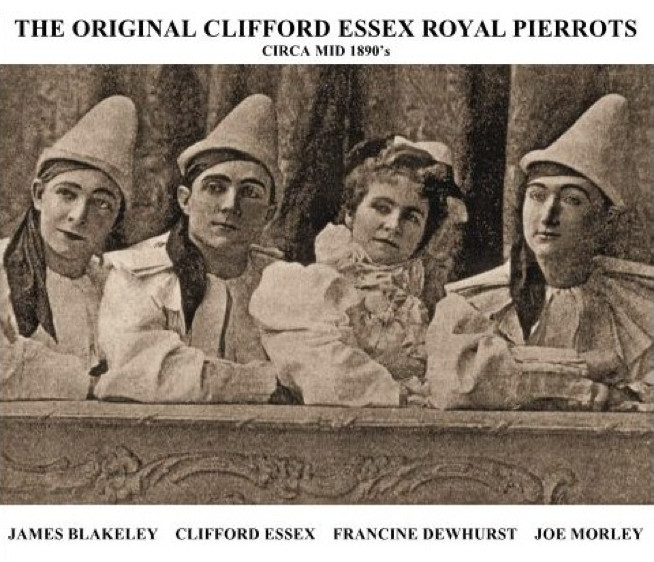

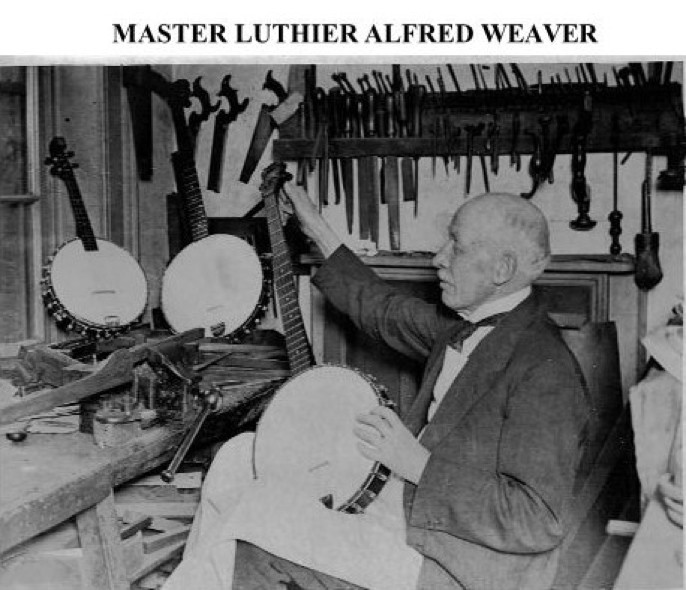
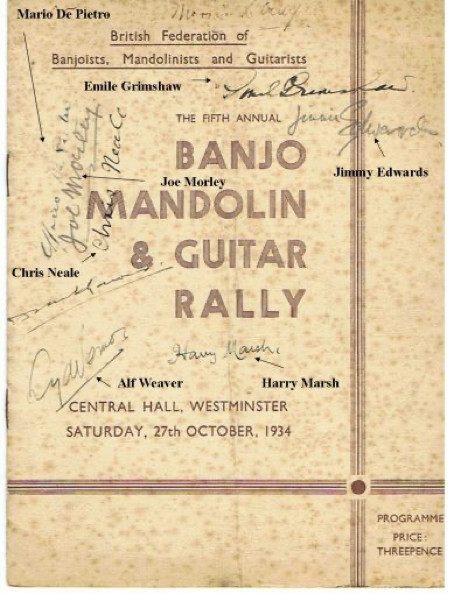
The 1934 Banjo, Mandolin & Guitar Rally
saw the launch of the new Clifford Essex Paragon Guitar: Price £15.00.
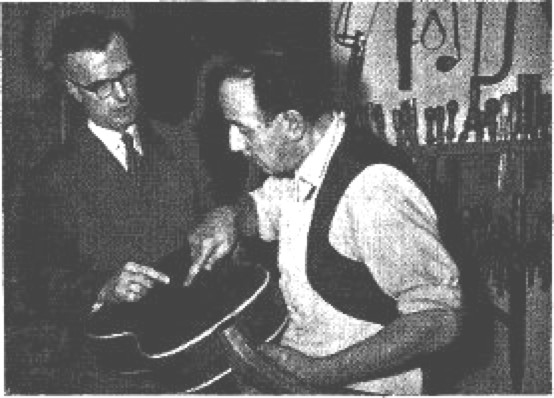
A P. Sharpe (left) discusses guitar construction with Marco Roccia in the Clifford Essex workshop
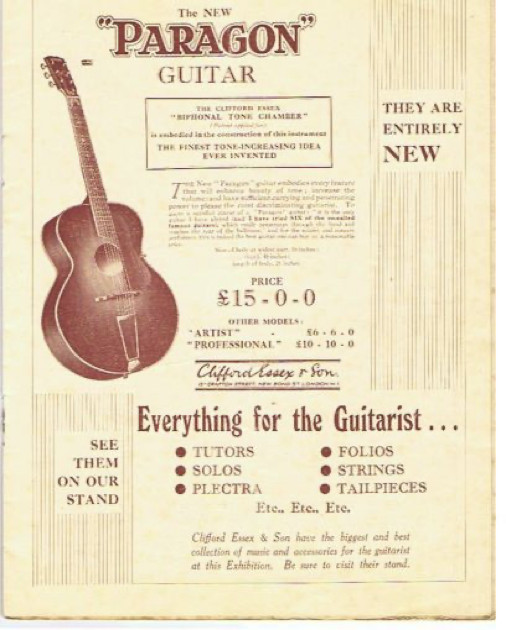
The following is adapted from Emile Grimshaw’s Plectrum Playing for Modern Banjoists, which was completely updated by American plectrum banjoist Ron Hinkle and English plectrum banjoist Clem Vickery.
There was always a banjo in the East London home of the Vickery family. Clem’s father played, as did his sea-captain grandfather before him. While growing up in the 1950s, young Clem revered his dad by constantly dabbling with the banjo, but it was his mother who noted his keen interest in the instrument, and at the age of nine she sent him for lessons with the then prominent banjo, mandolin and guitar teacher, Len Stotter.
From the very first lesson Len took Clem through the original version of this book, and throughout those early years, he helped Clem perfect most of the Emile Grimshaw plectrum banjo solos.
On leaving Plaistow Grammar school in 1965, Clem was very briefly employed as a telecommunications engineer apprentice, but the allure of music was too strong and Clem resolved to work in the music business. He spent an entire day in London’s West End visiting music shops seeking work, with no success. On the verge of giving up, he wandered into Earlham Street and, completely by chance, stumbled upon Clifford Essex Music Co. Ltd. Banjos, guitars and mandolins were on display in plate glass wall cabinets, so to young Clem it was like heaven. He hastened in to ask for work. Following a lengthy interview with A. P. Sharpe he was given the grand job of General Office Boy!
At that time many of the great players from before the war were regular customers, still very active, and Clem took every opportunity to glean as much technical information as possible from them. He would often stay at the premises late into the night practising his new-found knowledge on a company banjo. Then, in the late 1960s came a day that would change his life. A smartly dressed gentleman walked into the shop looking to buy a plectrum banjo. He explained that he could not play, but that it was his ambition to learn. Clem demonstrated several plectrum banjos, and eventually the customer purchased one, giving a bewildered Clem his business card and requesting that he attend his office the following day.
That gentleman turned out to be a BBC television producer who introduced Clem to Ernest Maxim, the producer of the George Mitchell Minstrel Show. Clem’s mentor, A. P. Sharpe had passed away by then, so he had no hesitation in embarking on a career as a professional plectrum banjoist, — an occupation which was destined to last nearly forty years. For seven of those years he appeared as the musical speciality act in the Black & White Minstrel Show, both in the popular BBC television series and on the West End stage.
Whenever a plectrum banjo was required, the BBC had no hesitation in booking Clem, so he soon became a well-known player in the BBC Television Orchestra. He also became a regular speciality act in theatres throughout the country, becoming so popular that he was given his own thirteen-week television series with Yorkshire Television’s Mini Melodies.

Clem Vickery
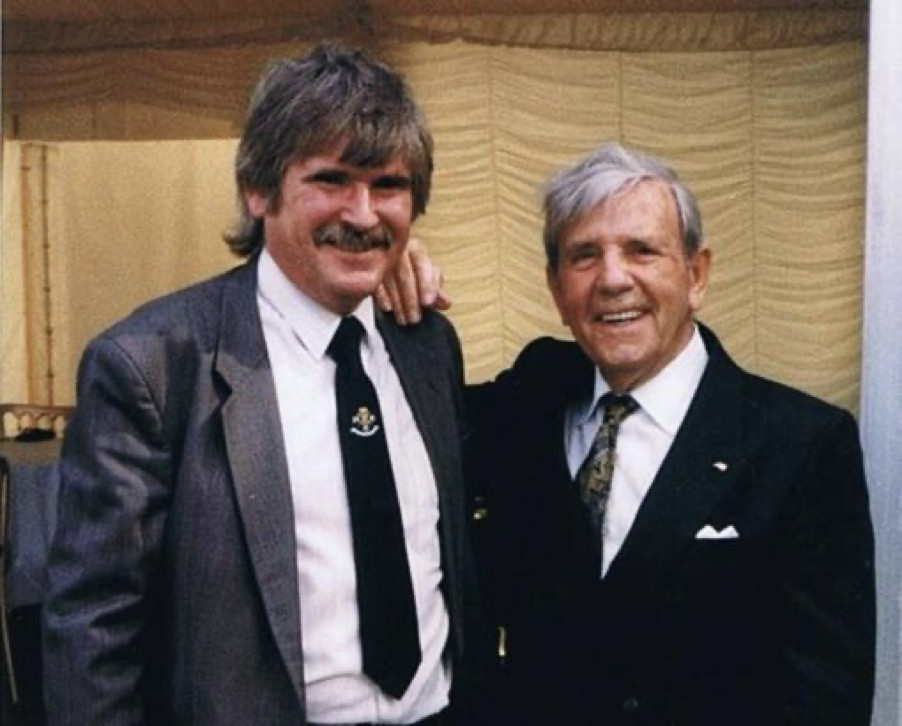
Clem Vickery & Norman Wisdom at Buckingham Palace where both entertainers were invited for tea for their valuable work in the community.
Clem had an abundance of musical experience, but he never regarded himself as a plectrum banjoist; he was always a musician first. That is why he was keen to contribute towards the update of Plectrum Playing for Modern Banjoists, believing it would help other banjoists to appreciate what Emile Grimshaw wrote in his Introduction: ‘a banjo can be just as expressive as any other musical instrument.’
Until his death in 2022, Clem was the managing director and editor of BMG, the oldest fretted instrument magazine in the world, founded by Clifford Essex in 1903. A satisfying anchorage for the grandson of a banjo-playing sea-captain. AVM.
Following in the footsteps of his father, Clem Vickery Jnr is now at the helm of Clifford Essex Music Co. Ltd. He has maintained strong links with the craftsmen and composers that his father had onboard to continue the company’s legacy of being a top-quality provider of instruments, accessories and sheet music.

